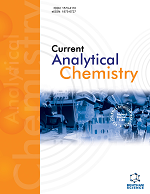- Home
- A-Z Publications
- Current Analytical Chemistry
- Previous Issues
- Volume 19, Issue 2, 2023
Current Analytical Chemistry - Volume 19, Issue 2, 2023
Volume 19, Issue 2, 2023
-
-
Polymeric Adsorbents: Innovative Materials for Water Treatments
More LessBackground: Removing heavy metal ions and various organic contaminants from water (surface water, groundwater, drinking water, and wastewater) using inexpensive and readily available adsorbents is essential in all environmental and human aspects. This study aims to explore the various adsorbents with a particular emphasis on polymeric adsorbents for their applications in the removal of heavy metal ions and em Read More
-
-
-
Perspective on Aggregation-induced Emission (AIE) Materials for Pathogen Detection
More LessAuthors: Chengcheng Zhou, Yaping Zhu and Weijiang GuanThe rapid and accurate identification of pathogens plays a crucial role in clinical practice, which helps to prevent, control, and treat pathogenic infections at the initial stage. The current available technologies for pathogen detection appear to be inadequate in dealing with cases such as COVID-19. More importantly, the frequent emergence of drug-resistant bacteria is gradually rendering the existing therapeutic options i Read More
-
-
-
Mini-Review on Analytical Methods Applied for Analysis and Characterization of Sericin
More LessSericin is a serine-rich polydispersed glycoprotein found in Bombyx mori's cocoons. Sericin is extracted from cocoons as a protein, composed of amino acids like aspartic acid, glycine, tyrosine, serine, and glutamic acid with carboxyl, hydroxyl, and an amino group. Sericin has been explored for various pharmacological activities, such as antioxidant, anti-inflammatory, antiapoptotic, antiproliferative, antibacterial, anti-hyperch Read More
-
-
-
Reverse Engineering of Medicinal and Nutritional Products - Approaches Available for Generic Product Development
More LessAuthors: Simran Kaur, Junaid U. Hamid and Sunil GuptaPharmaceutical preparations contain at least one active pharmaceutical ingredient and a wide range of excipients, each with a defined pharmaceutical purpose. India is known as the pharmacy of the world (manufacturing generic drug products). The market demand of generic products is increasing exponentially throughout the Asian and African regions. To satisfy the general population needs and competition i Read More
-
-
-
Analytical Methods for the Determination of Atypical Antipsychotic Drugs - An Update
More LessAuthors: Vasanti Suvarna and Adishri RautAtypical antipsychotics have gained incredible attention over the last decade and are widely prescribed for short-term and chronic treatment of various psychopathological diseases, including schizophrenia, mania, delirium, bipolar disorder, depression, autism spectrum disorder, and affective disorders. Due to their better clinical profile and therapeutic benefits, atypical antipsychotics have become a better choice for psychopa Read More
-
-
-
Hybrid Microfluidic-Flow Injection System for Determining Copper(II) in Aqueous Solution by Homemade Microfluidic-Chip
More LessAuthors: Ahmed S. Farhood and Dakhil N. TahaBackground: A new technique was designed for determining copper in an aqueous solution. Copper was determined by a hybrid system microfluidic coupled with flow injection. The homemade microfluidic chip (MFC) is used for injecting copper and 2,9-Dimethyl-1,10-phenanthroline (2,9 DMP) reagent as a merging zone technique, whereas uric acid is used as a reducing agent and carrier. Methods: A microfluidic chip was made Read More
-
-
-
Extraction and Analysis of Microplastic Beads from Personal Care Products
More LessAuthors: Pinal S. Bhavsar and Anil H. GoreBackground: Nowadays, plastic accumulation in marine has become one of the topics of global concern, with emerging research efforts focusing on the threat of microbeads (<5mm). A source of microplastic pollution is derived from personal care products (facial cleanser) that contain polyethylene microplastic (microbeads), which are not captured by the wastewater treatment plant. These small particles are especially Read More
-
-
-
Differential Calorimetric Sensor for Rapid H2O2 Quantification in Industrial Solutions
More LessAuthors: Roumen Zlatev, Margarita Stoytcheva, Benjamín Valdez and Mario CurielIntroduction: A simple and inexpensive differential calorimetric sensor for rapid hydrogen peroxide (H2O2) quantification in industrial solutions was developed, characterized and validated. An earlier method proposed by the authors, on which the developed sensor is based, was enhanced, allowing overcoming the issues with its practical application. Thus, the following goals were achieved: a response time of 195 s from sa Read More
-
Volumes & issues
-
Volume 21 (2025)
-
Volume 20 (2024)
-
Volume 19 (2023)
-
Volume 18 (2022)
-
Volume 17 (2021)
-
Volume 16 (2020)
-
Volume 15 (2019)
-
Volume 14 (2018)
-
Volume 13 (2017)
-
Volume 12 (2016)
-
Volume 11 (2015)
-
Volume 10 (2014)
-
Volume 9 (2013)
-
Volume 8 (2012)
-
Volume 7 (2011)
-
Volume 6 (2010)
-
Volume 5 (2009)
-
Volume 4 (2008)
-
Volume 3 (2007)
-
Volume 2 (2006)
-
Volume 1 (2005)
Most Read This Month
Article
content/journals/cac
Journal
10
5
false
en


